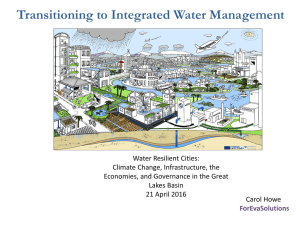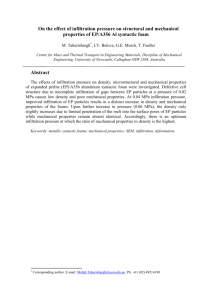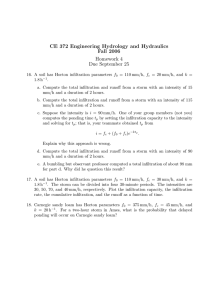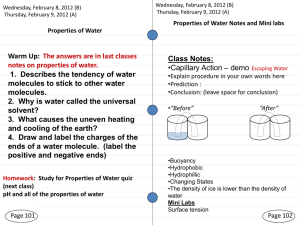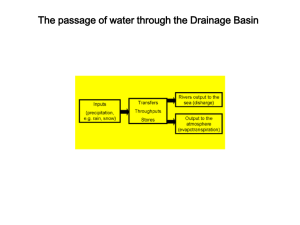Infiltration Basin (Acre-Feet) (1003)
advertisement
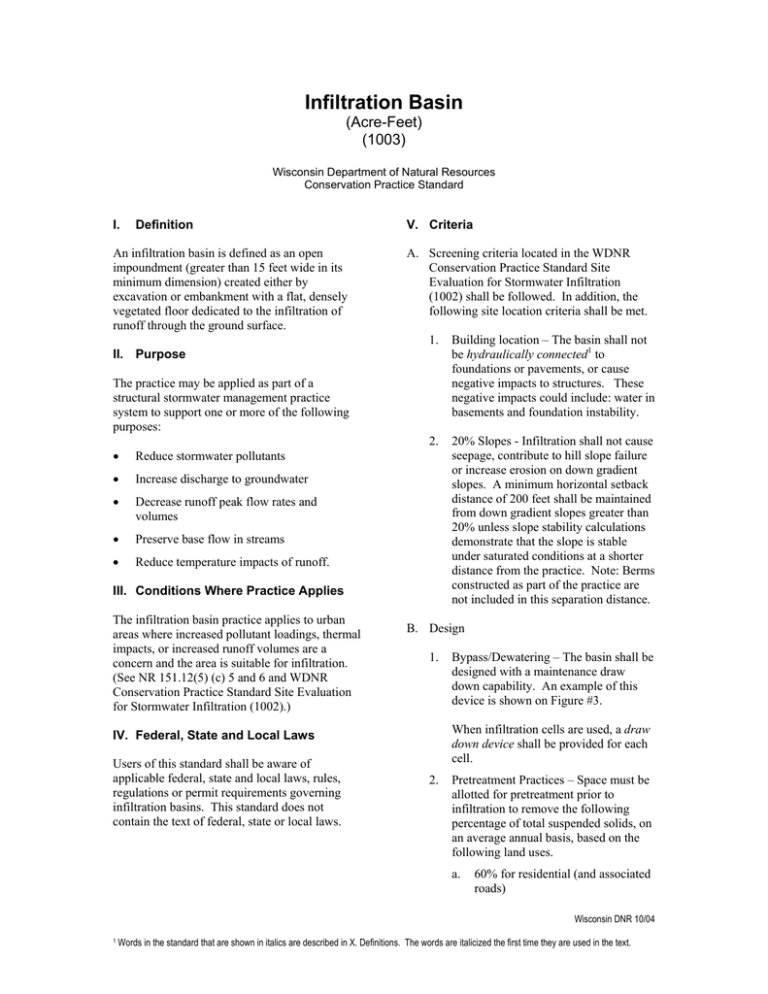
Infiltration Basin (Acre-Feet) (1003) Wisconsin Department of Natural Resources Conservation Practice Standard I. Definition An infiltration basin is defined as an open impoundment (greater than 15 feet wide in its minimum dimension) created either by excavation or embankment with a flat, densely vegetated floor dedicated to the infiltration of runoff through the ground surface. V. Criteria A. Screening criteria located in the WDNR Conservation Practice Standard Site Evaluation for Stormwater Infiltration (1002) shall be followed. In addition, the following site location criteria shall be met. 1. Building location – The basin shall not be hydraulically connected1 to foundations or pavements, or cause negative impacts to structures. These negative impacts could include: water in basements and foundation instability. 2. 20% Slopes - Infiltration shall not cause seepage, contribute to hill slope failure or increase erosion on down gradient slopes. A minimum horizontal setback distance of 200 feet shall be maintained from down gradient slopes greater than 20% unless slope stability calculations demonstrate that the slope is stable under saturated conditions at a shorter distance from the practice. Note: Berms constructed as part of the practice are not included in this separation distance. II. Purpose The practice may be applied as part of a structural stormwater management practice system to support one or more of the following purposes: • Reduce stormwater pollutants • Increase discharge to groundwater • Decrease runoff peak flow rates and volumes • Preserve base flow in streams • Reduce temperature impacts of runoff. III. Conditions Where Practice Applies The infiltration basin practice applies to urban areas where increased pollutant loadings, thermal impacts, or increased runoff volumes are a concern and the area is suitable for infiltration. (See NR 151.12(5) (c) 5 and 6 and WDNR Conservation Practice Standard Site Evaluation for Stormwater Infiltration (1002).) B. Design 1. When infiltration cells are used, a draw down device shall be provided for each cell. IV. Federal, State and Local Laws Users of this standard shall be aware of applicable federal, state and local laws, rules, regulations or permit requirements governing infiltration basins. This standard does not contain the text of federal, state or local laws. Bypass/Dewatering – The basin shall be designed with a maintenance draw down capability. An example of this device is shown on Figure #3. 2. Pretreatment Practices – Space must be allotted for pretreatment prior to infiltration to remove the following percentage of total suspended solids, on an average annual basis, based on the following land uses. a. 60% for residential (and associated roads) Wisconsin DNR 10/04 1 Words in the standard that are shown in italics are described in X. Definitions. The words are italicized the first time they are used in the text. b. 80% for commercial, industrial, institutional (and associated roads) 3. Infiltration Rates - See WDNR Conservation Practice Standard Site Evaluation for Stormwater Infiltration (1002) for design infiltration rates. 4. Dimensions a. Depth – Depth is a function of the maximum draw down time of 24 hours (for the infiltration portion of the practice only), using the design infiltration rate, with a not to exceed depth of 24 inches. The maximum depth of 24 inches applies to all infiltration cells within the practice. b. Target Stay-on Depth – The target stay-on depth shall meet the requirements of NR 151. (See Consideration L.) c. Effective Infiltration Area – The maximum depth along with the storage volume of water to be infiltrated can be used to determine the preliminary effective infiltration area necessary for the infiltration basin. (See Consideration L.) d. Slopes 1. 2. Longitudinal Slope – If used, the longitudinal slope shall not exceed 1% (0% longitudinal slope is recommended). If any longitudinal slope is specified, “infiltration cells” as described in V.B.4.f. shall be required. Lateral Slopes in the effective infiltration area shall be 0%. Example: (This example is a continuation of the 20 acre mixed land use example presented in “Technical Note for Sizing Infiltration Basins and Bioretention Devices to Meet State of Wisconsin Stormwater Infiltration Performance Standards.” See Consideration L. for reference.) This example assumed an average pre-development curve number of 75 for the pre-development soil condition in the drainage basin, sandy loam soils at the infiltration site and a post-development curve number of 70 for the pervious areas in the drainage basin. From that example, the preliminary effective infiltration area is 8,930 square feet or 0.2 acres. Therefore, the storage volume (SV) at a one-foot maximum depth (MD) is 0.2 acre-ft or 8,930 cu. ft. Calculate the dimensions of the basin. Assume a rectangular basin with a length to width ratio of 3:1 SV=MD * L * W substitute L=3W SV=MD * 3W2. Solve for W: 8,930 cu. ft. = 1 X 3W2 2,977 = W2 W = 55 ft L= 3W so L = 164 ft If using a longitudinal slope, it is still required that the maximum depth, at any point in the basin, not exceed 24 inches (or in this case 12 inches due to the soil type). This slope results in a 3D triangle of infiltration volume versus the cubic volume created by a basin with a flat floor. To correct for this and to provide the required infiltration volume, the preliminary effective infiltration area originally calculated must be divided by 0.5. This will correct for the triangle of lost volume created by the sloped floor of the basin, the maximum depth and the water surface. 2 WDNR 10/04 Example (continued) 8,930 sq. ft. / 0.5 = 17,860 sq. ft. The new W and L are now W = 77ft. and L = 3W = 231ft. Given: MD = 12 inches, SA = 17, 860 sq. ft., longitudinal slope = 1%. W = 77 ft. L = 231 ft. Note: The surface area calculated is the minimum effective infiltration area and does not include slopes or setbacks. Additional site area will be needed to account for berms and slopes. e. Side Slopes – All side slopes for interior and exterior berms shall have a 4:1 slope (horizontal: vertical) or flatter. f. Infiltration Cells – To maximize the effective infiltration area utilized and to prevent channelized flow, the effective infiltration area shall be subdivided into multiple smaller “cells” using level spreaders (example shown in Figure 1 & 2). These “cells” shall be used if a longitudinal slope is specified or if the length of the flow path exceeds 300 linear feet. With a length of 231 feet and a slope of 1% we know the basin rises 2.3 feet along its length from the outlet to the toe of the pre-treatment area. Given a 12-inch maximum depth of water in the practice for infiltration, the basin needs to be divided into multiple cells with each cell a maximum 300 feet length or a maximum of 12 inches of depth in each cell. As this example has a longitudinal slope of 1% the maximum cell is 100 feet in length (100 * 1% = 1 feet which is the maximum depth). Had this basin had no longitudinal slope on the floor, a cell up to 300 feet long could have been utilized. The first level spreader should be located 100 feet upstream from the outlet structure. This leaves us with 131 feet to the pretreatment area. At 1% slope, the height of the level spreader should be 1.3 feet, which is greater than allowed. So the second level spreader should be 1 foot in height, with the third being 100 more feet upstream with a height of 0.43 feet. The effective infiltration area shall be divided such that as a downstream cell reaches the depth of its level spreader, the elevation of the water in that cell does not exceed the downstream toe of slope from the next upstream level spreader. The height of any level spreader shall not exceed the maximum ponding depth. Note: To improve the aesthetics of the basin, the second and third cells may be evened out to two cells of 66 feet each and level spreader heights of 0.66 feet. 5. Basin Inlets and Cell Dividers / Level Spreader – The design shall evenly spread the outflow from the pretreatment device or between cells across the width of the basin. The pretreatment discharge pipes and stone trench shown in Figures 1 & 2 (plan and profile view) provide an example of level spreaders. 6. Basin Outlets – The infiltration basin outlet shall safely convey stormwater WDNR 10/04 3 from the start of construction in the drainage area, all infiltration basins shall be brought on-line. Build out means that the lot has been fully developed and stabilized from erosion. If the infiltration basin area is to also provide peak flow control for the fully built out 5-year, 24-hour event or greater, then a bypass device to divert those flows into the practice will be allowed until the infiltration basin is brought fully on-line. Erosion and sediment control practices shall be implemented for the remaining 10-25% of the undeveloped lots with the goal of preventing any sediment from reaching the infiltration basin. from the basin through all of the following mechanisms. An example of outlet pipes is shown in Figures 3 & 4 (front and side view) a. Draw Down Device – A means shall be provided to quickly remove standing water from the basins for maintenance and winter diversion. b. Emergency Spillway – A means shall be provided to release discharge in excess of the infiltration volume safely into the downstream stormwater conveyance system. The spillway shall be designed for a 100 year 24hour storm event. c. Freeboard – One foot of freeboard above the flow depth in the spillway shall be provided. 7. Maintenance Access – Provide a 12 foot wide access route, with a 6:1 slope, to the floor of the basin for sediment and debris removal. 8. Embankment Construction – Embankments shall conform with WDNR Conservation Practice Standard Wet Detention Basin (1001). A basin embankment may be regulated as a dam under ch. 31 Stats., and further restricted under ch. NR 333, Wis. Adm. Code, which includes regulations for embankment heights and storage capacities. 3. 2. 4 No disturbance – The infiltration area shall be fenced off to prevent heavy equipment access during development. b. Compaction Mitigation – If the active infiltration area is graded the effects of compaction shall be mitigated using the following methods: (2) The soil mix (V.C.3.b.1) shall be incorporated into the existing soil using a chisel plow or rotary device with the capability of reaching to 12 inches below the existing surface. Construction shall be suspended during periods of rainfall or snowmelt. Construction shall remain suspended if ponded water is present or if residual soil moisture contributes significantly to the potential for soil smearing, clumping or other forms of compaction. An assessment of the active erosion in the drainage area to the infiltration basin shall be performed to determine when to bring the infiltration basin online. The basin shall be brought on-line when the area draining to the basin has achieved 90% build out of all lots in any of the first 3 years or 75% build out in any subsequent year. By 5 years a. (1) Incorporate soil additives consisting of two inches of compost mixed into two inches of topsoil. C. Construction 1. During construction one of the following methods shall be used: (3) The compost component shall meet the following WDNR Specification S100 Compost. 4. The basin shall be constructed to the grades, elevations, and specifications in the plan. After grading and top soiling, the elevation of the basin shall be surveyed for conformance to design specifications. WDNR 10/04 Environmental Testing Verification protocol. D. Vegetation Cover 1. Establishment – Cover crops need to be applied in conjunction with the initial seeding of permanent vegetation. When establishing turf type grass, use the criteria contained in the DNR Conservation Practice Standard Seeding for Construction Site Erosion Control (1059). Sod shall not be used. If turf grass is utilized, the basin cannot be used for recreational purposes due to compaction concerns. 2. Native Seeding – Native vegetation shall be established in conformance with recommendations from a qualified native nursery in the area. If trees are to be used, species shall be selected that will not interfere with the function of the basin, or cause maintenance problems. Section IX References, lists sources that provide suggested seed mixtures. Native (prairie) seeding shall be completed in the fall (as dormant seeding prior to first snowfall) or in the spring (between May 1 and June 20), or plugs shall be used. 3. Fertilizer – Soil testing shall be used to determine proper applications for nutrients and liming. Fertilizer application shall conform to the criteria located in NRCS Conservation Practice Technical Standard, Critical Area Planting (342) or WDNR Conservation Practice Standard Seeding for Construction Site Erosion Control (1059). 4. Mulch – Mulch shall conform to the criteria located in WDNR Conservation Practice Standard Mulching for Construction Sites (1058). VI. Considerations A. Pretreatment Options - See WDNR Conservation Practice Technical Standards Wet Detention Basin (1001), Ditch Check (1062), and Vegetated Infiltration Swale (1005) for guidance. Estimates of pollutant reduction by proprietary devices should be based on monitoring using the EPA B. Well Locations - If well locations in relation to the basin are a concern, the site should be evaluated for the direction of ground water flow. C. Multiple Uses - Basins can be used for both infiltration and peak shaving as shown on Figure 1 and 2. However, another option is to include a flow splitter or diversion prior to pretreatment. By limiting the inflow into a BMP, a flow splitter can enhance the longevity of the BMP by reducing the volumetric rate of treatment, erosion or scour, and vegetation damage. Flow splitters need to be designed to address site conditions and flows. D. Drainage Area Size – The drainage area should be between 5 and 50 acres. If the drainage area is more than 50 acres, multiple basins should be provided. E. Regulatory Caps - Ch. NR 151 provides for a maximum area to be dedicated for infiltration depending upon land use. This cap can be voluntarily exceeded. F. Native Vegetation - The use of prairie grass or other deep-rooted plants is encouraged because these plants can increase the infiltration capacity of the basin. Dense vegetation will also reduce soil erosion on the basin floor. G. Level Spreader - Since it is often difficult to construct a level spreader, a combination of a berm and stone trench is recommended. Other methods to disperse flows include irrigation practices such as ridge and furrow irrigation systems. Refer to American Society of Agricultural Engineering Standards for guidelines on construction of irrigation dispersal systems. H. Tracked vehicles should be used during construction to lessen compaction. I. The final grading should be conducted by the landscape contractor so that the drainage area can be stabilized first. J. Snow should not be placed in the effective infiltration area. It may be placed on the WDNR 10/04 5 pretreatment area or areas draining into the pretreatment area. K. Internally Drained Watersheds – There are unique considerations for watersheds that are closed basins which are internally drained. Infiltration basins constructed in internally drained watersheds shall meet the requirements of NR 151 and this standard. Storms with a recurrence interval greater than a 2-year 24-hour storm must also be considered in the design and engineering judgment may determine that criteria such as draw down time and maximum depth may be exceeded for these larger storms. Infiltration basins in internally drained watershed may have different needs for plants, pretreatment, safety, maintenance or other characteristic that must be considered during design and construction. L. The DNR has created a technical note that may be used to size infiltration basins. The “Technical Note for Sizing Infiltration Basins and Bioretention Devices To Meet State Of Wisconsin Stormwater Infiltration Performance Standards” contains an approved method to determine the target stay-on depth and 12 design charts that can be used to size these basins for a variety of conditions. In addition, the technical note contains a reference to an approved infiltration model (RECARGA) that can also be used to determine effective infiltration area requirements. Other models may be used if approved. The Technical Note can be accessed at: http://dnr.wi.gov/org/water/wm/nps/stormwa ter/techstds.htm#Post VII. Plans and Specifications Plans and specifications shall be prepared in accordance with the criteria of this standard and shall describe the requirements for applying the practice to achieve its intended use. Plans shall specify the materials, construction processes, location, size and elevations of all components of the practice to allow for certification of construction upon completion. VIII.Operations and Maintenance An operation and maintenance plan shall be developed that is consistent with the purposes of this practice, intended life of the components, 6 safety requirements, and the criteria for the design. There may be state and local laws that require adequate O&M of public and private facilities and the identification of responsible parties. At a minimum, the plan shall include: A. Inspection Intervals – At minimum, quarterly inspections shall occur. Inspection shall include spreader and overflow spillway for indication of failure. Note the condition of vegetation as part of inspection. If standing water is observed over 50% of the basin floor 3 days after rainfall, the basin is clogged and measures should be undertaken to unclog it. (See section VIII.C). B. Native Vegetation - Maintenance of Native Vegetation – Mowing (cutting) or burning shall be used to maintain the vegetation. 1. Establishment - The first mowing of newly planted seed shall occur once it reaches a height of 10 to 12 inches. 2. Mowing 3. a. Mowing shall reduce the height of plants to 5 to 6 inches. b. After establishment, if burning cannot be accommodated, mowing shall occur once in the fall (after November 1). The area shall be mowed to a height of 5 to 6 inches. Burning a. Routine Maintenance - Beginning the second year, burning shall occur in the early spring (prior to May 1st) or in the late fall (after November 1st) b. Burning shall be done two consecutive years and then up to three years can pass before the next burning. c. Under no circumstances shall burning occur every other year. C. Restoration Procedures – these include removing the top 2 to 3 inches, chisel plowing and adding topsoil and compost. If deep tilling is used, the basin shall be drained and the soils dried to a depth of 8 inches. If the basin was planted in turf grass and clogging again occurs after these restoration procedures have been used, the owner /operator shall replant with prairie WDNR 10/04 style vegetation using the soil preparation method recommended by the native nursery in the area. D. Trash shall be removed as quickly as possible once observed. E. Pretreatment – If wet detention is used, see WDNR Conservation Practice Technical Standard Wet Detention Basin (1001) for operations and maintenance requirements. F. Winter Maintenance – All draw down devices in the pond shall be opened during winter months to discourage infiltration of runoff water containing high levels of chlorides. If this practice is an enclosed basin, the use of chloride deicers shall be limited in the area draining to the basin to reduce the chance of exceeding the limits in ch. NR 140. Flow Splitter (VI.C): A flow splitter is a device used to direct a fraction of runoff into the BMP facility while bypassing excess flows from larger storm events. Hydraulically connected (V.A.1.): Two entities are said to be hydraulically connected if a surface or subsurface conduit exists between the two such that water is transmitted from one entity to the other. Level spreader (V.B.4.f): A level spreader is a device used to disperse concentrated flows back over a wide area, dissipating the energy of the runoff and promoting sheet flow. Common types of level spreaders include vegetated, earthen or stone berms, weirs and stone trenches. Target Stay-on Depth (IV.B.4.b.): The amount of infiltration required on an average annual basis. It is the portion of the annual rainfall (inches) on the development site that must be infiltrated on an annual basis to meet the infiltration goal. IX. References Metropolitan Council, 2003. Urban Small Sites Best Management Practice Manual, Chapter 3, Vegetative Methods 3-85 – 3-91. Minneapolis. United States Department of Agriculture – Natural Resources Conservation Service. Engineering Field Handbook, Chapters 16 and 18. UWEX Publication A3434 Lawn and Establishment & Renovation. WisDOT, 2003. State of Wisconsin Standard Specifications for Highway and Structure Construction. Section 630, Seeding. X. Definitions Draw down device (V.B.1): A draw down device can consist of any device that allows for the dewatering of the infiltration basin or the infiltration cells down to the ground elevation. Examples include removable weir plates (shown in Figure 3), pipes with valves, weirs with removable stop logs. Effective infiltration area (V.B.4.c.): An effective infiltration area means the area of the infiltration system that is used to infiltrate runoff and does not include the area used for site access, berms or pretreatment. WDNR 10/04 7

